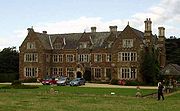
Launde Abbey
Encyclopedia

Leicestershire
Leicestershire is a landlocked county in the English Midlands. It takes its name from the heavily populated City of Leicester, traditionally its administrative centre, although the City of Leicester unitary authority is today administered separately from the rest of Leicestershire...
, 14 miles east of the city of Leicester
Leicester
Leicester is a city and unitary authority in the East Midlands of England, and the county town of Leicestershire. The city lies on the River Soar and at the edge of the National Forest...
and six miles south west of Oakham
Oakham
-Oakham's horseshoes:Traditionally, members of royalty and peers of the realm who visited or passed through the town had to pay a forfeit in the form of a horseshoe...
. The building is presently used as a conference and retreat centre, by the Church of England
Church of England
The Church of England is the officially established Christian church in England and the Mother Church of the worldwide Anglican Communion. The church considers itself within the tradition of Western Christianity and dates its formal establishment principally to the mission to England by St...
Dioceses of Leicester
Diocese of Leicester
The Diocese of Leicester is a Church of England diocese based in Leicester and including the current county of Leicestershire. The cathedral is Leicester Cathedral, where the Bishop of Leicester has his seat....
and Peterborough.
The Abbey is an Elizabethan Manor House, extensively modified, originally built on the site of an Augustinian Priory
Priory
A priory is a house of men or women under religious vows that is headed by a prior or prioress. Priories may be houses of mendicant friars or religious sisters , or monasteries of monks or nuns .The Benedictines and their offshoots , the Premonstratensians, and the...
. The original priory was founded in 1125 by Richard Basset
Richard Basset (royal justice)
Richard Basset was an English royal judge and sheriff during the reign of King Henry I of England. His father was also a royal justice. In about 1122 Basset married the eventual heiress of another other royal justice; the marriage settlement has survived. In 1129 and 1130 Basset was sheriff of a...
and his wife Matilda.
Launde is set in beautiful countryside. Thomas Cromwell, Henry VIII
Henry VIII of England
Henry VIII was King of England from 21 April 1509 until his death. He was Lord, and later King, of Ireland, as well as continuing the nominal claim by the English monarchs to the Kingdom of France...
's chief minister responsible for the dissolution of the monasteries
Dissolution of the Monasteries
The Dissolution of the Monasteries, sometimes referred to as the Suppression of the Monasteries, was the set of administrative and legal processes between 1536 and 1541 by which Henry VIII disbanded monasteries, priories, convents and friaries in England, Wales and Ireland; appropriated their...
, so liked its position that he wrote in his diary "Myself for Launde". But Cromwell never occupied the house as he was executed in 1540 for treason. In that same the year the building of the new house commenced. His son, Gregory
Gregory Cromwell, 1st Baron Cromwell
Gregory Cromwell, 1st Baron Cromwell, KB was an English peer.-Early life:Cromwell was born in Putney, then in Surrey, the first child and only son of Thomas Cromwell, later 1st Baron Cromwell and briefly 1st Earl of Essex, and his first wife, the former Elizabeth Wykys.He was tutored by Sir...
, lived at Launde Abbey for ten years after its construction with his wife Elizabeth, the sister of Jane Seymour
Jane Seymour
Jane Seymour was Queen of England as the third wife of King Henry VIII. She succeeded Anne Boleyn as queen consort following the latter's execution for trumped up charges of high treason, incest and adultery in May 1536. She died of postnatal complications less than two weeks after the birth of...
, the third wife of Henry VIII.

Nikolaus Pevsner
Sir Nikolaus Bernhard Leon Pevsner, CBE, FBA was a German-born British scholar of history of art and, especially, of history of architecture...
has described the monument to Gregory Cromwell as "one of the purest monuments of the early Renaissance in England". The chapel is used for daily worship by the resident community and guests, and is an attraction for visitors.
In 2009 the Abbey launched a successful £1 million appeal to bring the house up to the standards required by legislation. If the money was not raised, the Abbey would be forced to close.

